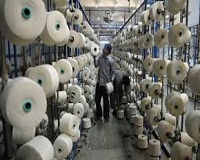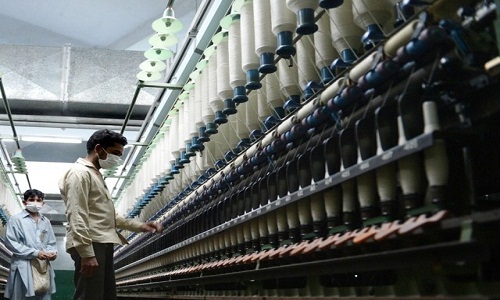FW
"A recent report suggests ‘Made in US’ clothing is gaining ground with the government’s thrust and companies’ near-shoring strategies. The focus is on high-quality US craftsmanship priced competitively with imports. This proposition makes perfect sense for manufacturers and sellers as the entire supply chain is in their hands rather than depending on the external factors. These increasingly growing state of affairs is giving rise to ‘grown and sewn in the US’ phenomenon, where e-commerce lets small firms tell a story and sell directly to consumers who have an interest in natural fibres such as cotton and wool, a willingness to invest in longer-lasting higher-quality goods and a desire to shop local."
 A recent report suggests ‘Made in US’ clothing is gaining ground with the government’s thrust and companies’ near-shoring strategies. The focus is on high-quality US craftsmanship priced competitively with imports. This proposition makes perfect sense for manufacturers and sellers as the entire supply chain is in their hands rather than depending on the external factors. These increasingly growing state of affairs is giving rise to ‘grown and sewn in the US’ phenomenon, where e-commerce lets small firms tell a story and sell directly to consumers who have an interest in natural fibres such as cotton and wool, a willingness to invest in longer-lasting higher-quality goods and a desire to shop local.
A recent report suggests ‘Made in US’ clothing is gaining ground with the government’s thrust and companies’ near-shoring strategies. The focus is on high-quality US craftsmanship priced competitively with imports. This proposition makes perfect sense for manufacturers and sellers as the entire supply chain is in their hands rather than depending on the external factors. These increasingly growing state of affairs is giving rise to ‘grown and sewn in the US’ phenomenon, where e-commerce lets small firms tell a story and sell directly to consumers who have an interest in natural fibres such as cotton and wool, a willingness to invest in longer-lasting higher-quality goods and a desire to shop local.
Numerous start-ups are flourishing from this idea. For instance, McIntosh, founder of Homegrown Cotton, wasn’t satisfied with the imported polo shirts costing from $80 to $90. Thanks to changing paradigms, every step of the process is done in North and South Carolina. The shirt’s final cutting and sewing happens 40 miles from his farm. Similarly, Anna Brakefield and Mark Yeager, father-daughter owners of Alabama-based Red Land Cotton, started their bedding and towel brand a ‘farm-to-home’ product. By growing and ginning their own cotton, they create a higher-quality fibre, which is spun, woven and finished in South Carolina and Georgia before being sewn in their hometown. Earlier they were unable to find sewers who could do some of the finer detail hemming for their sheets, later found a small-scale sewing firm in their hometown to finish the sheets.
Quest for organic cotton
A growing perception is that people in the US are increasingly opting for US made clothing. A survey by Cotton Incorporated showed 66 per cent consumers say they are interested in buying US-made clothing made with US-grown cotton. Rob McMillian, Founder of Chicago-based Dearborn Denim, says when he started the company in 2016, he wanted to create an all-American apparel company that produced high-quality products at an affordable price to show that locally made goods don’t have to be more expensive. Even though the manufacturing costs are higher in Chicago than using foreign products and labour, the e-commerce route helped keep costs down. His women’s and men’s jeans cost around $60, competitive with prices of jeans from The Gap and Levi’s.
consumers say they are interested in buying US-made clothing made with US-grown cotton. Rob McMillian, Founder of Chicago-based Dearborn Denim, says when he started the company in 2016, he wanted to create an all-American apparel company that produced high-quality products at an affordable price to show that locally made goods don’t have to be more expensive. Even though the manufacturing costs are higher in Chicago than using foreign products and labour, the e-commerce route helped keep costs down. His women’s and men’s jeans cost around $60, competitive with prices of jeans from The Gap and Levi’s.
Tom Chappell, Founder of Ramblers Way, offers organic wool and cotton clothing online and does custom-made clothes in their shops in Maine and New Hampshire, said it took a lot of trial and error to get the fabric quality he wanted and to do it sustainably. They built their own factory in Canton, Mass., to create a superfine worsted Rambouillet merino and organic merino wool that wasn’t itchy and could be worn year-round.
"The Pakistan textile industry is facing tough times. Textile funds over Rs 200 billion ($US 1.56 billion), in the form of export rebate, sales tax refunds, etc, are stuck with the government. This is compelling industry to buy electricity and gas at an expensive rate compared to other countries in the region. Even water has to be procured through the tanker mafia. Despite all these hurdles, Pakistan’s exports have marked increase this year; the credit goes solely to exporters. Last year the government had announced a package of Rs 180 billion($US 1.40 billion) out of this, only Rs 25-30 billion($US 0.19-0.20 billion) was released. The earlier governments did not consider releasing the stuck up money. If released, this may bring more dollars through higher exports."
 The Pakistan textile industry is facing tough times. Textile funds over Rs 200 billion ($US 1.56 billion), in the form of export rebate, sales tax refunds, etc, are stuck with the government. This is compelling industry to buy electricity and gas at an expensive rate compared to other countries in the region. Even water has to be procured through the tanker mafia. Despite all these hurdles, Pakistan’s exports have marked increase this year; the credit goes solely to exporters.
The Pakistan textile industry is facing tough times. Textile funds over Rs 200 billion ($US 1.56 billion), in the form of export rebate, sales tax refunds, etc, are stuck with the government. This is compelling industry to buy electricity and gas at an expensive rate compared to other countries in the region. Even water has to be procured through the tanker mafia. Despite all these hurdles, Pakistan’s exports have marked increase this year; the credit goes solely to exporters.
Erroneous policies
Last year the government had announced a package of Rs 180 billion($US 1.40 billion) out of this, only Rs 25-30 billion($US 0.19-0.20 billion) was released. The earlier governments did not consider releasing the stuck up money. If released, this may bring more dollars through higher exports.
The decision of the finance ministry to devalue the local currency further hurt profits of local exporters and 20 per cent depreciation in rupee made import of raw material more expensive. Exporters say, devaluation of the local currency by the government encourages foreign buyers to demand a share of this devaluation leaving nothing for exporters.
of raw material more expensive. Exporters say, devaluation of the local currency by the government encourages foreign buyers to demand a share of this devaluation leaving nothing for exporters.
Profits on rupee depreciation
Despite the furore from the textile industry, analyst Shanker Talreja of Topline Securities observes profitability of textile sector increased 10 per cent in the current fiscal, while financial cost of companies declared in the quarterly result was 30 per cent. Major profit of textile companies occurred from the depreciation of the Pak rupee.
Declining investments
With potential investors hesitant to make new investments due to rising business costs, Pakistan’s textile industry has experienced decreasing investments over the last decade. Due to this, the sector has missed out on many technological advantages to competitors.
New investments dropped to more than half a billion rupees($US 390 million) in 2016-17, compared to Rs 1 billion($US 780 million) in 2005-06. Further, about 35 per cent of the textile industry’s production capacity was damaged, causing loss of approximately $4.14 billion worth of potential exports.
According to Pakistan Bureau of Statistics, while textile sector performed poorly, the exports of readymade garments registered a 13 percent year-on-year growth in July-May 2017-18, which stood at $2.346 billion in 2017-18
Corrective measures proposed
APTMA members proposed a long list of corrective and conducive policy measures to the government in return for their investments, including implementation of long-term policies, like consistent nationwide energy prices, removal of Rs 3.50 (3 cents) per kilowatt-hour surcharge on electricity tariff, an extension of the duty drawback scheme for five years and drawbacks to be increased every year by 1 percent for garments (up to 12 percent) and made-ups (up to 10 percent) against realisation of export proceeds.
The proposal also recommends long-term financing facility (LTFF) to indirect exports, Islamic financing and building of infrastructure for garment plants, a decrease in the electricity tariff in line with regional players, timely release of pending refunds, continuation of the drawback duties and reduction/elimination of the customs duties on import of synthetic yarn and Polyester Staple Fiber (PSF). It remains to be seen how many of these are actually implemented.
The American cotton industry seems to be plagued with many difficulties such as the age-old fumigation rules on import of US commodity in Bangladesh. These rules not only impose an additional cost burden on importers and spinners in Bangladesh but also results in increased lead time.
Apart from this, the US cotton industry leaders also noted phytosanitary requirement as a major hurdle for the import of cotton in the country. In addition, they also identified the distance between the two countries and the congestion at the Chittagong port as major hurdles for increasing US cotton shipment in Bangladesh.
China recently imposed 25 per cent retaliatory duty on the import of cotton from the US as part of the 'trade war' between the two countries. Reflecting on this, the US cotton industry insiders said that the move might result in slight changes in the trade flow of cotton across the world.
Premiere Vision New York was held from July 17 to 18. The trade show presented a comprehensive array of seminars, services and displays amid the European-centric, but globally represented fabric exhibitors. There’s a paradox that exists for the industry now: the US economy is strong, but the administration has caused chaos with the imposition of tariffs that have been countered by China, the European Union and Canada, and the threat of more.
The fashion industry in the US is struggling. This includes retailers trying to shift their business models in accordance with the e-commerce boom and changing consumer priorities, but also fighting with travel, electronics, home and entertainment for consumer dollars.
The show focused on delivering a more comprehensive presentation. It has taken to technology by creating an app that can be downloaded to guide visitors around the show, as they would be at an art museum. More trend presentations and talks were also introduced, along with smart talk seminars and displays.
Moving ahead with new technologies and the evolution of the trade show, Premiere Vision will launch a new digital online marketplace—starting with weavers—at Première Vision Paris in September. It will contain a catalog of resources and materials in the sector to augment the hands-on trade show experience.
British shoppers stepped up purchases the most in over a decade in the second quarter despite lower spending in June, giving the Bank of England some reassurance that tahe sluggish start to 2018 is over. Retail sales volumes in June alone unexpectedly fell 0.5 per cent from May at the low end of economists’ forecasts as the World Cup kept some shoppers out of stores after extremely rapid growth during the previous two months. Overall economic growth in Britain this year is likely to be the weakest since 2012.
The latest retail sales data showed clothing sales suffered from the heat, but food and drink retailers did well as shoppers took advantage of unusually hot weather. However, old-style clothing retailers such as Marks & Spencer, Debenhams and House of Fraser have struggled, and furniture retailers DFS and Dunelm reported lack lustre results, in part due to hot weather keeping shoppers away.
Retail sales growth and Britain's economy overall slowed in the first three months of 2018, due to heavy snow as well as ongoing pressures from high inflation and the anticipation of next year's Brexit, and the BoE stated in May that it would delay raising rates until it was sure that growth was back on track.
Sales for the second quarter as a whole were 2.1 per cent higher than the first three months of the year, the biggest calendar-quarter increase since the first quarter of 2004.
Thailand and Colombia may join the Trans-Pacific Partnership. The UK is seeking public feedback on the idea, wanting to prevent its isolation from the rest of the world after it exits the European Union. South Korea is said to have contacted multiple members about joining, while Taiwan, eager to counter mainland China's push for its own trade sphere, has shown interest as well.
Mexico, Japan and Singapore have already ratified the agreement, with Vietnam and two others set to do so by year-end. The bloc comes into force 60 days after at least six members ratify it. The Trans-Pacific Partnership has a membership of eleven countries.
A dedicated committee will be set up to iron out the exact process for bringing in newcomers. The bloc will not renegotiate its rules on intellectual property and other trade issues, but tariff rates will be worked out between each existing and new member.
The US pulled out of the original 12-member TPP in 2017 before it could even be ratified. The agreement has now been revived as the TPP-11. Along with reducing tariffs, the agreement will set rules for a wide range of fields, including e-commerce and intellectual property, making exports from members like Vietnam or Chile more competitive within the bloc than those from nonmembers.
The Tamil Nadu government has made elaborate plans to improve cotton production. These include the proactive measures taken in wake of the recent unavailability of cotton and its soaring prices. The Tamil Nadu government emphasised the need to improve cotton production adding that the sericulture department is chalking out a plan to increase silk production to enable Tamil Nadu to be self-sufficient.
The government also plans to set up a Common Effluent Treatment Plants (CETP) to address the effluent issue that was affecting water bodies besides the common man, weavers and the textile industry. The government met with stiff resistance from the public for setting up of a CETP in their locality. At present the government is offering 49 per cent subsidy for the establishment of CETPs.
The CETP at Tirupur has been set up at a cost of Rs 700 crore and has received a subsidy of Rs 175 crore besides an interest-free loan of Rs 200 crore. In the near future, the government is willing to set up many more CETPs.
Footwear maker Skechers USA Inc’s shares declined recently after same-store sales missed estimates in the second quarter ended June 30, 2018. Net earnings of the company were reported to be $45.3 million, declining by 24 percent year-over-year. Sales grew 10.6 per cent as a result of a 24.9 per cent increase in the company’s international wholesale business, and 12.8 per cent increase in its company-owned global retail business. Sales reached $1.13 billion.
Comparable same store sales in company-owned stores worldwide grew by 4.5 per cent, including a 2.2 per cent rise in the United States and an 11.3 per cent increase internationally, however the company suffered from a weak domestic wholesale business, which fell 7 per cent, and a 6.1 per cent decrease in the company’s international distributor business.
For the third quarter of 2018, the company expects to reach sales in the range of $1.200 billion to $1.225 billion, and diluted earnings per share of $0.50 to $0.55.
High street fashion retailer Primark has announced a three-year partnership with UNICEF where both will collaborate on education and emergency response. In total, Primark will commit $4.5 million towards UNICEF’s education work and a further $1.5 million has been pledged to support emergency response efforts following humanitarian crises.
Primark’s contribution to the charity’s education fund will enable vulnerable children to attend and keep their place in Cambodian schools. Activities in the program will include targeted support for children from minority language groups, children with disabilities and girls, investment in school sanitation facilities, and training for teachers in positive discipline approaches.
In 2017, UNICEF’s emergency response arm – which Primark is now directly supporting – responded to 337 humanitarian situations in 102 countries, most of which included children at risk, with women and children comprising 60 - 80 per cent of the affected population.
Spanish garment retailer Inditex will pilot at-home pick up service for recycled garments in China this September. The initiative, which currently operates nationwide in Spain, is a central part of the group’s strategic commitment to the so-called circular economy. It has enabled the collection of more than 25,000 tons of garments in 21 markets since launching in 2016.
The company’s integrated store and online model has boosted Inditex’s sustained growth. All of Inditex’s brands benefit from a robust integrated store and online platform. Last year, online sales accounted for 12 per cent of the total in the 47 markets in which e-commerce platforms are available, representing annual growth of 41 per cent.
The model has enabled sustained growth over the years, coupled with the consistent creation of economic, social and environmental value. Inditex owns international fashion brand Zara. Inditex has also recently embarked on a refurbishment drive for its entire global network of more than 7400 stores, accompanied by considerable growth in the Zara online platform.
Competitors have been unable to fully replicate Inditex's business model, which takes clothes from design to rack in weeks. The company’s gross profit margin is expected to bottom out this year as currency headwinds ease.












